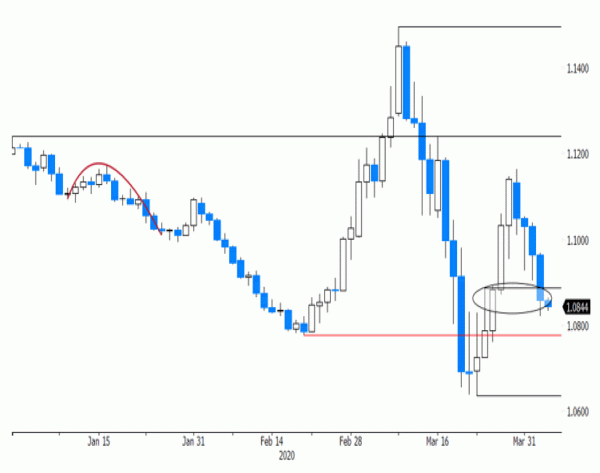- Rates: US payrolls won’t capture full blow of corona lockdown
Trading ranges on core bonds markets are gradually returning to normal after an extremely volatile month of March. Risk sentiment remains extremely fragile and could benefit bonds in a return of their traditional negative correlation. Today’s US payrolls and non-manufacturing ISM won’t capture the full blow of the coronavirus. - Currencies: EUR/USD decline accelerates on… jump in US jobless claims
Yesterday, ongoing negative (eco) news continued to support the dollar. The US currency even rallied after a sharp rise in US jobless claims. Among the big three (USD, euro, yen), the single currency remains an underperformer. EUR/JPY is nearing an important support area, illustrating the yen’s status as ‘second best’ safe haven next to the USD.
The Sunrise Headlines
- US stocks climbed on hopes for a truce in the oil price war, shrugging of horrible unemployment numbers. The S&P 500 (+2.28%) outperformed. Asian markets fall with Australia a standout decliner (-2.33%).
- Oil prices soared nearly 50% (Brent $36.29p/b, WTI 27.39p/b) after US president Trump stoked fresh hopes for a truce in the Russian-Saudi-Arabian oil price spat, announcing possible coordinated output cuts of up to 15mln bpd.
- The China Caixin services PMI rebounded in March to 43 from 26.5 but still marks the second-lowest level since the survey began. Businesses cut jobs at the fastest pace on record as (export) orders dropped and scrambled to cut costs.
- The BoE is doubling the size of its corporate bond purchase programme to at least £20bn to combat the coronacrisis. The UK government is reportedly setting up a new emergency support package for midsized companies.
- Moody’s reviewed its outlook for US non-bank mortgage lenders from stable to negative warning of a big wave of delinquencies and intense liquidity pressures as a rising number of unemployed borrowers are expected to default.
- Japanese PM Abe announced the government is rolling out an emergency stimulus package next week to fight the coronacrisis. The bill targets small business and households and will a.o. include targeted cash handouts.
- In today’s economic calendar all eyes are on US labour market data (payrolls, weekly earnings and hours) and the non-manufacturing ISM. However, the payrolls will only catch the front-edge of the US economic shutdown
Currencies: EUR/USD Decline Accelerates On… Jump In US Jobless claims
Poor US data don’t hurt dollar
Yesterday, the established FX trends continued. The preference for the dollar remains firmly in place even as US data signal economic activity is also falling of a cliff. Even more, the EUR/USD decline even accelerated after US weekly jobless claims jumped an unprecedented 6.6 mln. Also the (temporary?) spike in oil prices was seen USD supportive. US yields recently declined more than German ones and basis swaps indicate that the scarcity of the liquidity in the money market has been ‘addressed’ by recent Fed/CB measures. It has all little to no impact. EUR/USD closed the session at 1.0858 (from 1.0964). The trade-weighted dollar (DXY) regained the 100 barrier. Even USD/JPY rebounded after the US claims data, but yen remains an outperformer compared to the other majors.
This morning, Asian markets mostly show modest losses. The China Caixin services PMI printing at 43 (up from 26.5) only illustrates the difficult process of restarting economic. The oil price is easing after yesterday’s rebound as markets doubt the initiatives of president Trump will result in a deal, adding to overall market uncertainty. The yuan stabilizes (USD/CNY 70850 area). The PBOC indicated that it is in no hurry to cut the deposit rate further and that is making a more complete evaluation. AUD/USD stabilizes north of 0.60 (0.6070 area) as the RBA bond buying continues according to plan.
Today, the final EMU PMIs, the US non-manufacturing ISM and the US March payrolls will be published. US employment is expected to have declined by 100k. It is difficult to expect good news, also from the US data. However, for now, the dollar stays preferred regardless of (US) news flow. The picture in USD/JPY and in the trade-weighted dollar is a bit more ‘balanced’. The euro recently was an under performer against the USD amongst the majors. EUR/USD falling below the 1.09 area deteriorated the technical picture. Next support is seen near 1.0775 and at 1.0634. Also look for the EUR/JPY cross rate with the low 116 being a key support! A break could have impact on other (euro) cross rates.
Yesterday, the euro under performance also continued to filter through the EUR/GBP cross rate. The pair dropped to the 0.8750 area. Today, the final UK services PMI will be published. The drop below EUR/GBP 0.90 was a euro negative/sterling positive from a technical point of view. Still, we remain cautious to join this sterling rebound, but for now there is no trigger to fight this EUR/GBP decline.
EUR/USD drops below 1.09 area, deteriorating technical picture













